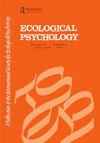野生猴子使用石器工具:对身体+工具系统研究的启示
IF 1.7
3区 心理学
Q3 PSYCHOLOGY, EXPERIMENTAL
引用次数: 5
摘要
摘要手持工具将演员的身体转化为一个身体加工具系统,这样演员的身体、工具和任务的配合就需要在动作中引导运动。在这项研究中,我们对巴西Fazenda Boa Vista的野生须卷尾猴Sapajus libidinosus的撞击动作进行了生物力学分析,因为它们从身体加工具系统的参考框架中用砧和锤子工具敲开了tucum螺母。锤子质量与身体质量的比例——“按身体比例缩放的锤子质量”——影响了猴子用锤子的动作以及它们敲碎坚果的表现。身体质量和锤子质量并没有独立影响猴子用锤子的动作和它们敲碎坚果的表现。这些发现支持了这样一种假设,即身体加工具系统的特性不仅仅是身体和工具特性的总和。本文章由计算机程序翻译,如有差异,请以英文原文为准。
Stone-Tool Use in Wild Monkeys: Implications for the Study of the Body-Plus-Tool System
ABSTRACT Handheld tools transform the actor's body into a body-plus-tool system such that the fit of the actor's body, the tool, and the task demand channel movement in action. In this study, we performed a biomechanical analysis of percussive actions in wild bearded capuchin monkeys, Sapajus libidinosus at Fazenda Boa Vista, Brazil, as they cracked open tucum nuts with anvil-and-hammer tools from the frame of reference of the body-plus-tool system. The ratio of hammer mass to body mass—the “body-scaled hammer mass”—influenced the monkeys' actions with a hammer and their performance in cracking nuts. Both body mass and hammer mass did not independently influence the monkeys' actions with a hammer and their performance in cracking nuts. These findings support the hypothesis that the properties of the body-plus-tool system are not simply the sum of the properties of the body and the tool.
求助全文
通过发布文献求助,成功后即可免费获取论文全文。
去求助
来源期刊

Ecological Psychology
PSYCHOLOGY, EXPERIMENTAL-
CiteScore
3.30
自引率
10.50%
发文量
8
期刊介绍:
This unique journal publishes original articles that contribute to the understanding of psychological and behavioral processes as they occur within the ecological constraints of animal-environment systems. It focuses on problems of perception, action, cognition, communication, learning, development, and evolution in all species, to the extent that those problems derive from a consideration of whole animal-environment systems, rather than animals or their environments in isolation from each other. Significant contributions may come from such diverse fields as human experimental psychology, developmental/social psychology, animal behavior, human factors, fine arts, communication, computer science, philosophy, physical education and therapy, speech and hearing, and vision research.
 求助内容:
求助内容: 应助结果提醒方式:
应助结果提醒方式:


